Abstract
To better understand the ecological significance of pressure effects on bacteria in the abyssobenthic boundary layer, experimental suspensions of sediments and sinking particulates were prepared from samples collected in boxcore and bottom-moored sediment traps at two stations (depth, 4,470 and 4,850m) in the Demerara abyssal plain off the coast of Brazil. Replicate samples were incubated shipboard at 3°C and at both atmospheric and deep-sea pressures (440 or 480 atm [4.46 × 104 or 4.86 × 104 kPa]) following the addition of [14C]glutamic acid (<10 μg liter−1) or yeast extract (0.025%) and the antibiotic nalidixic acid (0.002%). In seven of the eight samples supplemented with isotope, a barophilic microbial response was detected, i.e., substrate incorporation and respiration were greater under in situ pressure than at 1 atm (101.3 kPa). In the remaining sample, prepared from a sediment trap warmed to 24°C before recovery, pressure was observed to inhibit substrate utilization. Total bacterial counts by epifluorescence microscopy decreased with depth in each sediment core, as did utilization of glutamic acid. Significant percentages of the total bacterial populations in cold sediment trap samples (but not the prewarmed one or any boxcore sample) were abnormally enlarged and orange fluorescing after incubation with yeast extract and nalidixic acid under deep-sea conditions. Results indicated that in the deep sea, barophilic bacteria play a predominant role in the turnover of naturally low levels of glutamic acid, and the potential for intense microbial activity upon nutrient enrichment is more likely to occur in association with recently settled particulates, especially fecal pellets, than in buried sediments.
Full text
PDF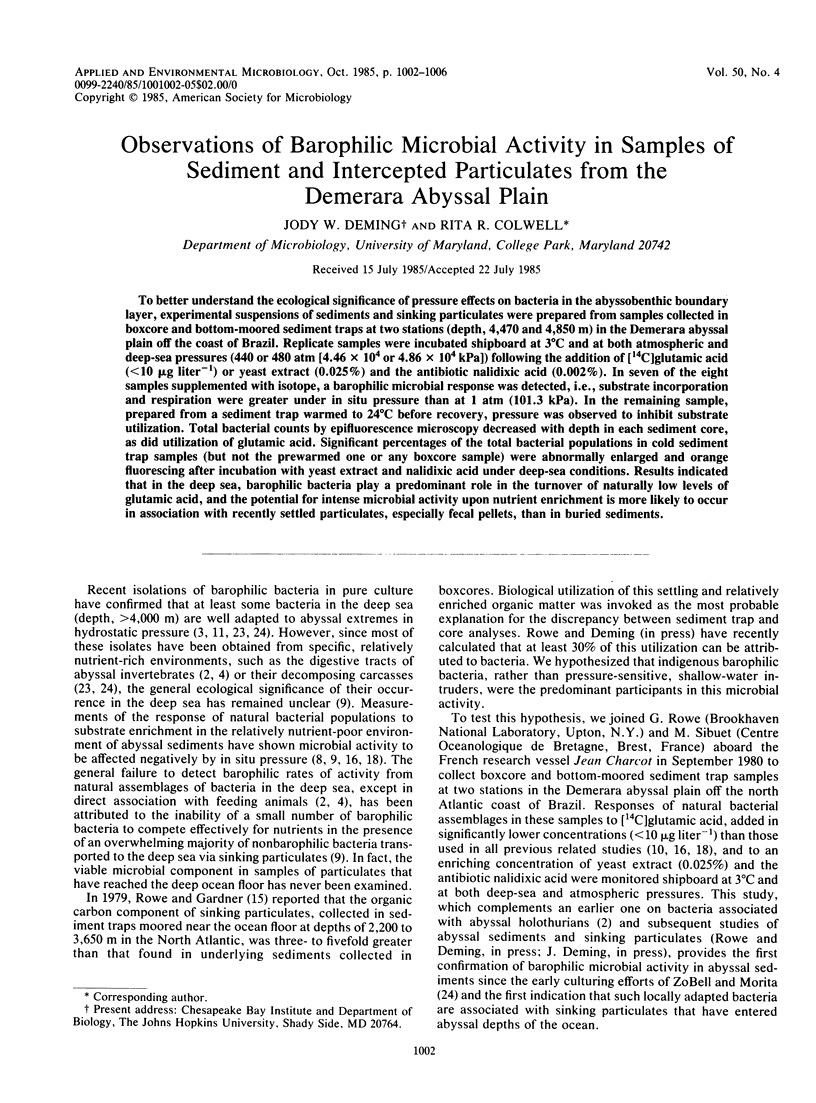
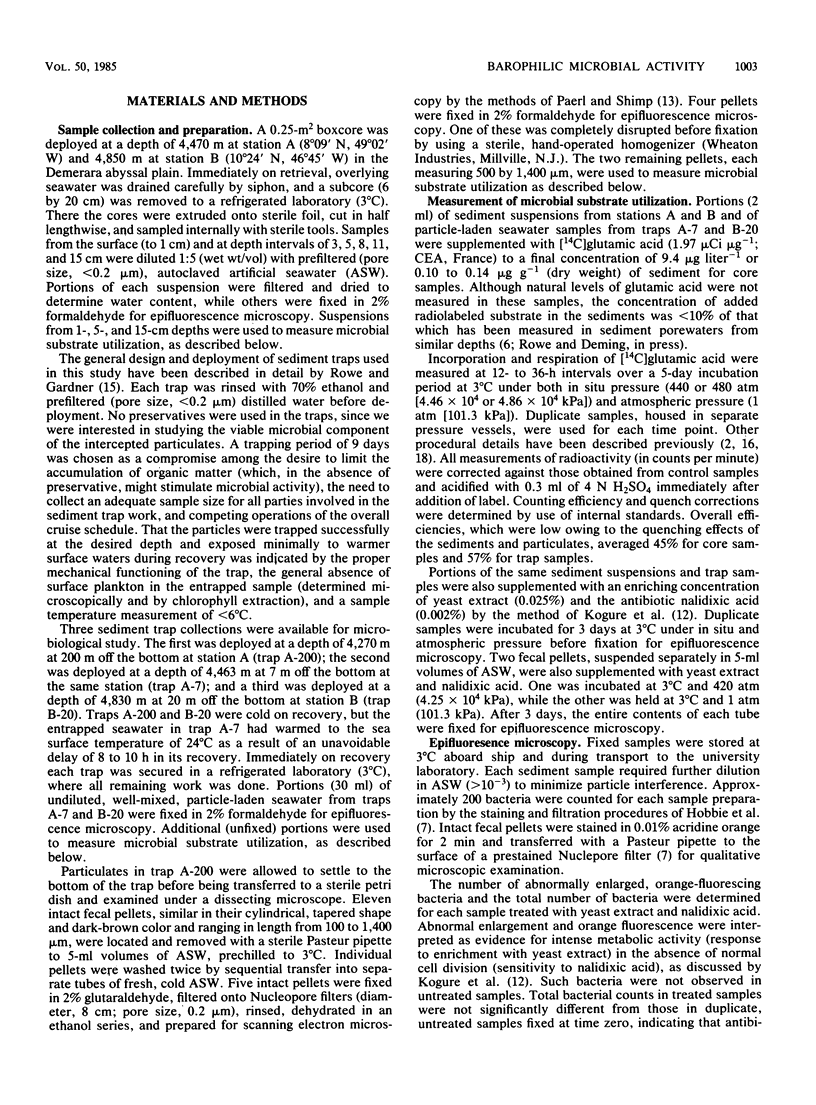
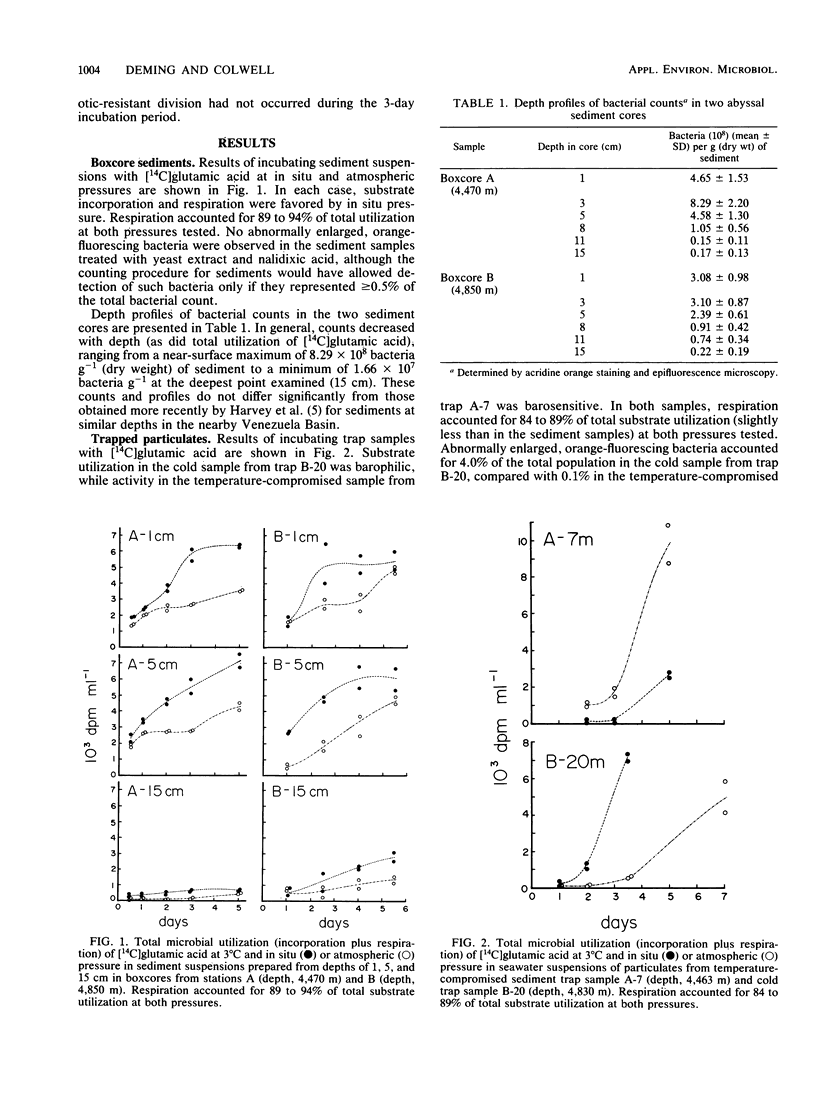
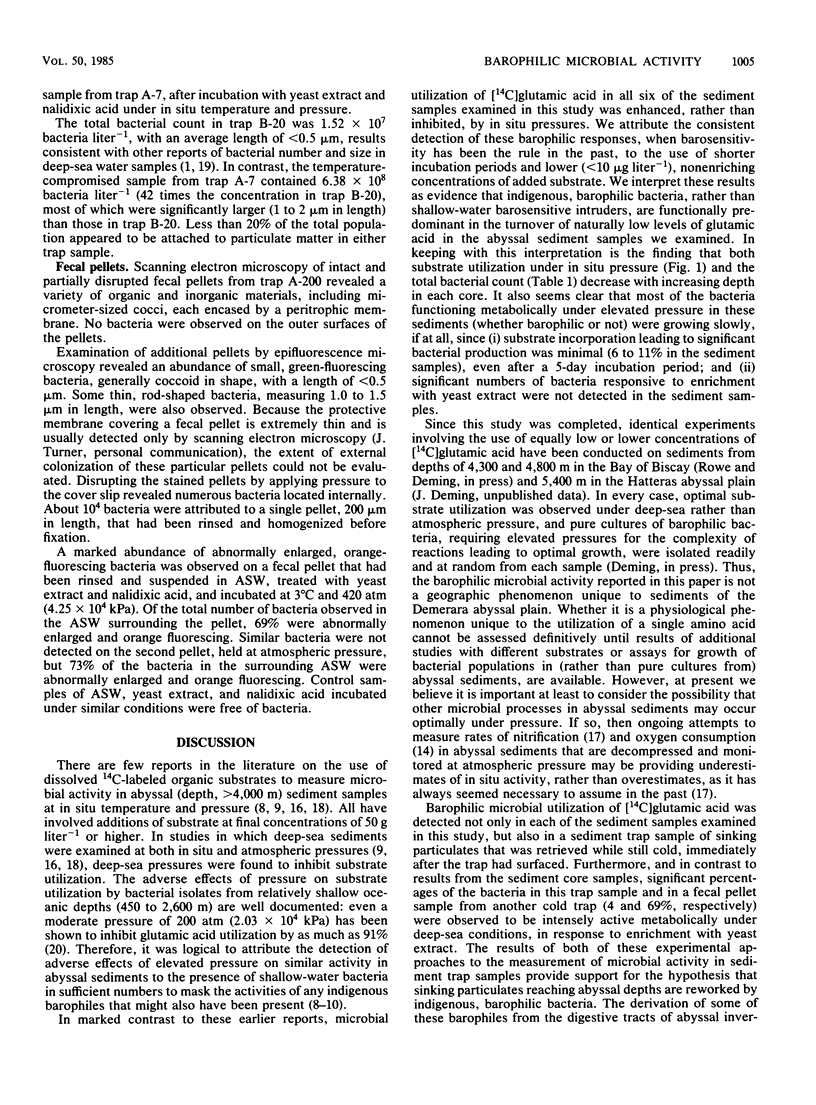
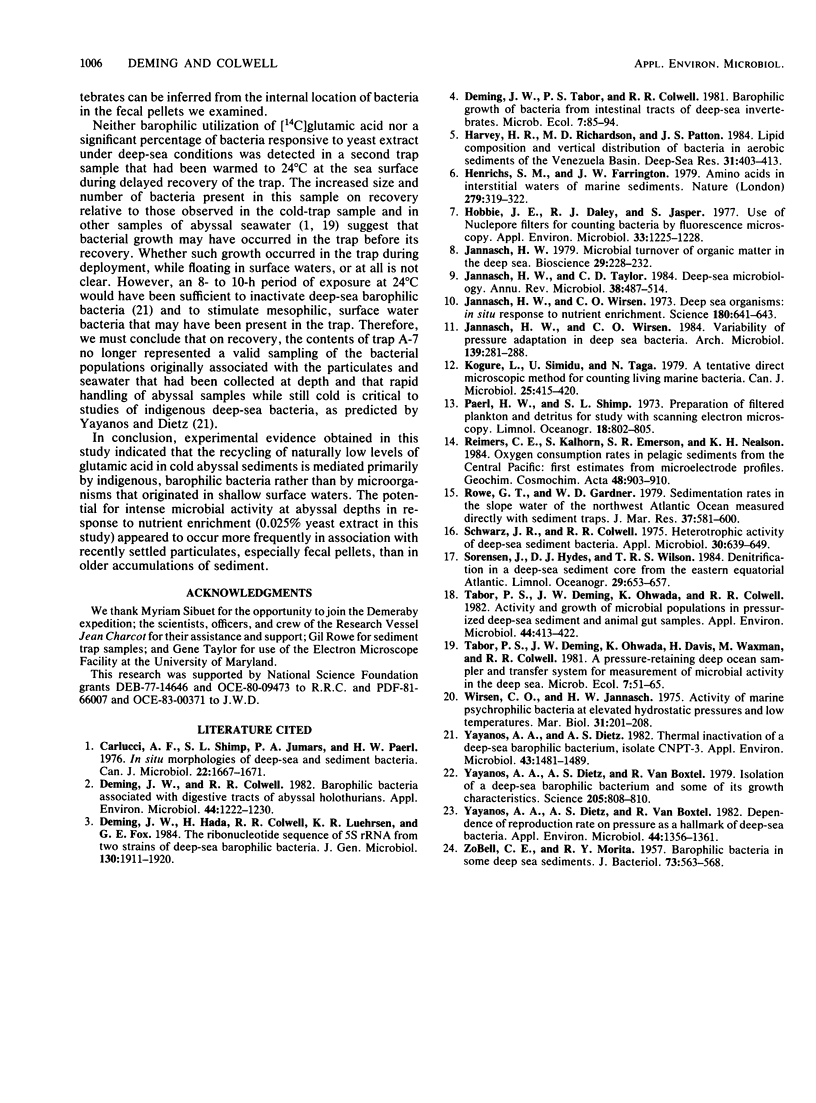
Selected References
These references are in PubMed. This may not be the complete list of references from this article.
- Carlucci A. F., Shimp S. L., Jumars P. A., Paerl H. W. In situ morphologies of deep-sea and sediment bacteria. Can J Microbiol. 1976 Nov;22(11):1667–1671. doi: 10.1139/m76-247. [DOI] [PubMed] [Google Scholar]
- Deming J. W., Colwell R. R. Barophilic bacteria associated with digestive tracts of abyssal holothurians. Appl Environ Microbiol. 1982 Nov;44(5):1222–1230. doi: 10.1128/aem.44.5.1222-1230.1982. [DOI] [PMC free article] [PubMed] [Google Scholar]
- Deming J. W., Hada H., Colwell R. R., Luehrsen K. R., Fox G. E. The ribonucleotide sequence of 5s rRNA from two strains of deep-sea barophilic bacteria. J Gen Microbiol. 1984 Aug;130(8):1911–1920. doi: 10.1099/00221287-130-8-1911. [DOI] [PubMed] [Google Scholar]
- Hobbie J. E., Daley R. J., Jasper S. Use of nuclepore filters for counting bacteria by fluorescence microscopy. Appl Environ Microbiol. 1977 May;33(5):1225–1228. doi: 10.1128/aem.33.5.1225-1228.1977. [DOI] [PMC free article] [PubMed] [Google Scholar]
- Jannasch H. W., Taylor C. D. Deep-sea microbiology. Annu Rev Microbiol. 1984;38:487–514. doi: 10.1146/annurev.mi.38.100184.002415. [DOI] [PubMed] [Google Scholar]
- Jannasch H. W., Wirsen C. O. Deep-Sea Microorganisms: In situ Response to Nutrient Enrichment. Science. 1973 May 11;180(4086):641–643. doi: 10.1126/science.180.4086.641. [DOI] [PubMed] [Google Scholar]
- Kogure K., Simidu U., Taga N. A tentative direct microscopic method for counting living marine bacteria. Can J Microbiol. 1979 Mar;25(3):415–420. doi: 10.1139/m79-063. [DOI] [PubMed] [Google Scholar]
- Schwarz J. R., Colwell R. R. Heterotrophic activity of deep-sea sediment bacteria. Appl Microbiol. 1975 Oct;30(4):639–649. doi: 10.1128/am.30.4.639-649.1975. [DOI] [PMC free article] [PubMed] [Google Scholar]
- Tabor P. S., Deming J. W., Ohwada K., Colwell R. R. Activity and growth of microbial populations in pressurized deep-sea sediment and animal gut samples. Appl Environ Microbiol. 1982 Aug;44(2):413–422. doi: 10.1128/aem.44.2.413-422.1982. [DOI] [PMC free article] [PubMed] [Google Scholar]
- Yayanos A. A., Dietz A. S. Thermal Inactivation of a Deep-Sea Barophilic Bacterium, Isolate CNPT-3. Appl Environ Microbiol. 1982 Jun;43(6):1481–1489. doi: 10.1128/aem.43.6.1481-1489.1982. [DOI] [PMC free article] [PubMed] [Google Scholar]
- Yayanos A. A., Dietz A. S., VAN Boxtel R. Isolation of a deep-sea barophilic bacterium and some of its growth characteristics. Science. 1979 Aug 24;205(4408):808–810. doi: 10.1126/science.205.4408.808. [DOI] [PubMed] [Google Scholar]
- Yayanos A. A., Dietz A. S., Van Boxtel R. Dependence of reproduction rate on pressure as a hallmark of deep-sea bacteria. Appl Environ Microbiol. 1982 Dec;44(6):1356–1361. doi: 10.1128/aem.44.6.1356-1361.1982. [DOI] [PMC free article] [PubMed] [Google Scholar]
- ZOBELL C. E., MORITA R. Y. Barophilic bacteria in some deep sea sediments. J Bacteriol. 1957 Apr;73(4):563–568. doi: 10.1128/jb.73.4.563-568.1957. [DOI] [PMC free article] [PubMed] [Google Scholar]


